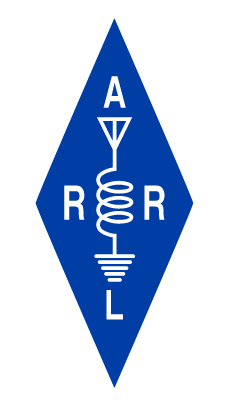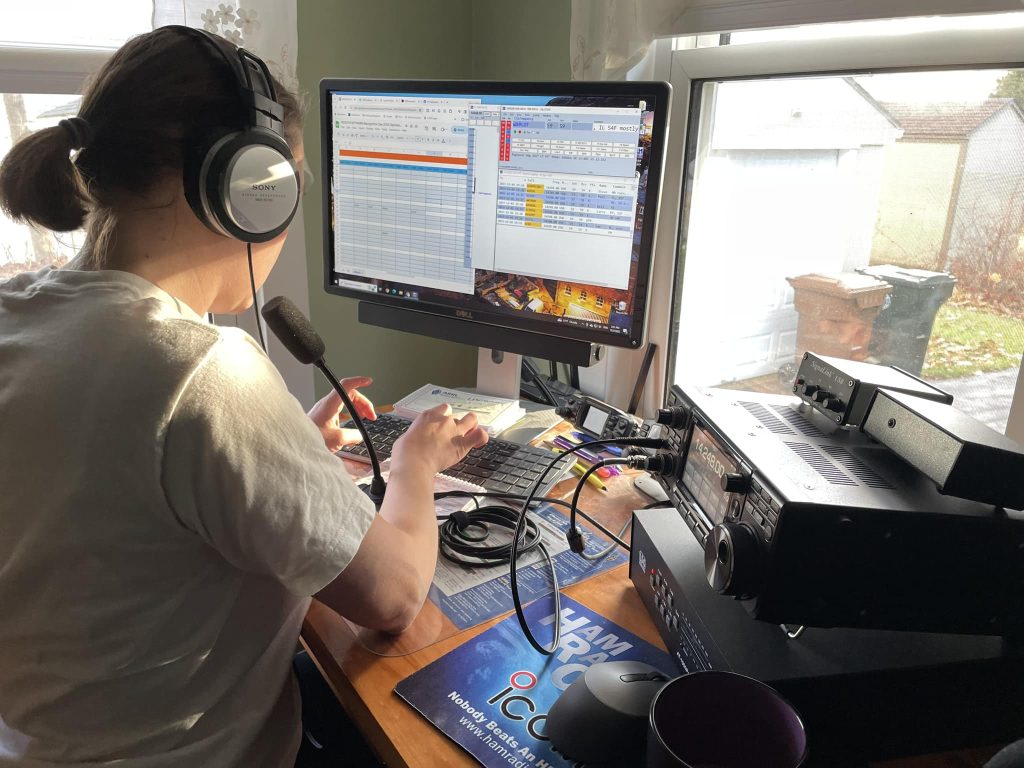 Phil Temples
Phil Temples
New Morse Code Game “Less is Morse” Now Online
Alan Dove, AB1XW, has released a new game for learning or practicing Morse code. The free game combines several different training options into a single, minimalist control panel. An HTML version that runs in most modern browsers is available, or users can download native versions for Windows, Mac, or Linux to play offline.
The default starting mode uses the popular Koch method for learning the code from scratch, sending characters at 22 words per minute but introducing them one at a time. Once a player is comfortable receiving the current character set, they can adjust the game level to add another character. The game will also level up automatically when the player is receiving the current characters consistently with at least 90% accuracy.
For intermediate and advanced users who already know the code, there are three modes that send random words from different lists. Players can also turn the speed up or down, adjust the audio tone, or randomize the tone so each new character or group gets sent at a different pitch.
All versions, and a full description of the game’s controls and options, can be found at https://radiovoice.itch.io/less-is-morse.
Alan, AB1XW is a member of the Hampden County Radio Association and lives in Longmeadow, MA with his family. He’s been a ham for over 30 years.
Western MA December 2023 Section News Now Available
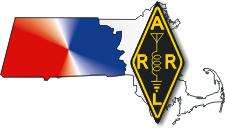 The December, 2023 Western MA Section Newsletter is now available at https://wma.arrl.org/blog/2023/12/04/section-manager-report-december-2023/.
The December, 2023 Western MA Section Newsletter is now available at https://wma.arrl.org/blog/2023/12/04/section-manager-report-december-2023/.
N1MRI Selected as OMISS “Top Op of the Month”
 Greater Bridgeport (CT) ARC Secretary Kevin Pfeiffer, N1MRI, has been chosen as “Top Op of the Month” by the O.M. International Sideband Society, according to GBARC Vice President Emily Clarke, NI1Q.
Greater Bridgeport (CT) ARC Secretary Kevin Pfeiffer, N1MRI, has been chosen as “Top Op of the Month” by the O.M. International Sideband Society, according to GBARC Vice President Emily Clarke, NI1Q.
“. . . N1MRI was bestowed a great honour by being nominated for and voted in as The OMISS Top Op for the month of November. Out of over 15,000 members, this is an amazing honour,” writes Clarke.
Congratulations, Kevin!
“Gerry’s Ham Radio Life: 48 Years of W1VE”
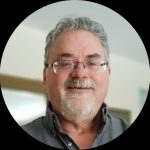 YouTube video blogger Kevin Thomas, W1DED, interviewed Gerry Hull, W1VE, recently:
YouTube video blogger Kevin Thomas, W1DED, interviewed Gerry Hull, W1VE, recently:
“There are many hams who can claim five decades of amateur radio but there are few who have been immersed in so many facets of the hobby as Gerry Hull, W1VE. Gerry is active throughout his native Canada with several VE callsigns, he’s well known for his expertise in the remote ham radio space, he’s consulted for and operated the AA7JV Radio-in-a-Box project, and was instrumental in creating the online contest scoreboard concept. He’s a competitive contester, consummate DXer, technical writer, a long-time member of the Yankee Clipper Contest Club, and more. In this interview, Gerry talks specifically about his recent CQ WW CW multi-op contest effort at the Maine superstation, K1LZ, and then we do a speed round of questions that cover some of his nearly 50 years in ham radio.”
Volunteer Registration for 2024 Boston Marathon Now Open
Boston Marathon Communications Committee <contact@hamradioboston.org>
Dec 7, 2023, 11:00 AM
Volunteer registration for the 2024 Boston Marathon opened yesterday. Returning volunteers have received an email from the BAA that included registration instructions. In order to make registration as smooth as possible, we are providing specific instructions for our Amateur Radio Operator (ARO) volunteers.
If you haven’t previously volunteered, or have a friend who would like to volunteer, please go directly to the Volunteer Registration page and follow the instructions for new volunteers.
Step by Step Sign Up Guide:
https://hamradioboston.freshdesk.com/support/solutions/articles/44002497536-2024-volunteer-registration-step-by-step-guide
A few notes for volunteers:
Almost all amateur radio positions are single person assignments. We are not able to group people on a single assignment, but we will try to accommodate which segment you are assigned to in order to allow for similar start/end times.
Don’t delay! Volunteer registration closes on Friday, February 2 at 5:00 PM EST. It would help our planning processes if you could complete your registration by Friday, January 26.
Help us get the word out by forwarding this email to your club and other amateur radio operators who might wish to volunteer. Most volunteers first learn about the event through word of mouth. If you know new licensees who might like to join us, please make sure to let them know about it. Even just a quick mention at your club meeting can be a big help!
If you have any questions about the upcoming volunteer registration period, or the 2024 Marathon generally, please get in touch anytime. Volunteering at the Marathon is a big job and we appreciate the time and effort everyone puts into it. We’re happy to do what we can to make your work fun, comfortable, and effective.
We look forward to seeing everyone again soon.
Thank you, and 73,
Boston Marathon Communications Committee
contact@HamRadioBoston.org
Please make sure to whitelist volunteer@baa.org and contact@HamRadioBoston.org to make sure you receive BAA and ARO committee communications.
NOTE: You must be at least 18 years old to volunteer for the Boston Marathon.
ARISS Webinar: “Owen Garriott, W5LFL,” December 7, 2023
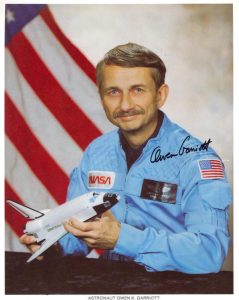
Rosalie White, K1STO, writes:
I hope you can tune in tomorrow (Thursday, December 7, 2023) to an ARISS webinar that ARISS’s Frank Bauer, KA3HDO, is hosting with Richard Garriott, W5KWQ.
Richard will talk about his dad Owen Garriott, W5LFL (SK), and his STS-9 NASA mission 40 years ago that resulted in the first ham radio contact from space—the first time an astronaut could talk to someone from space besides NASA and heads of countries.
The webinar tomorrow is at 1 pm Eastern, and here’s the URL: https://www.youtube.com/channel/UCxm5Ca2y0HD_NxXlZWXv11A
Richard Garriott Thursday, Dec. 7 at 1 pm Eastern
73,
Rosalie K1STO
Harvard Wireless Club Honored With 50-Year ARRL Affiliation Plaque
From ema.arrl.org:
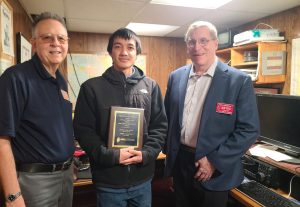
ARRL New England Division Director Fred Kemmerer, AB1OC, and Vice Director Phil Temples, K9HI, recently visited the W1AF club shack on the Harvard University campus in Cambridge, Massaschusetts, and awarded a 50-year ARRL affiliation plaque to HWC Vice President Cameron Lu, KC1LZI. The ARRL Board of Directors recognized the club in the form of an official motion at its July, 2023 meeting in Windsor, Connecticut.
The club has a distinguished history, and is one of the oldest radio clubs in the country. It was founded in 1909 as “The Radio Society of the Institute of Geographic Exploration at Harvard” and changed its name to the Harvard Wireless Club a year later.
Needed: Organizer for 2024 Project BIG E
 Larry Krainson, W1AST, writes on the Project BIG E mailing list:
Larry Krainson, W1AST, writes on the Project BIG E mailing list:
Dear Everyone,
I thank you for your ideas, commitment, and volunteering for the past two Project Big Es. We learned a lot over the past two years and this year went much better than last year.
I am stepping down as an organizer. I just cannot do it again; my wife would kill me if I tried.
I will turn over all my notes, spreadsheets, contacts, and materials to someone interested in continuing the booth.
By the way, we had 170 people sign up for ham classes. That list is being distributed to clubs that hold classes throughout New England. The ones much further away will be sent to the nearest Section Manager for distribution.
Along with all of the volunteers, the following people were indispensable in every aspect of making this year a success.
| Bob | K5TEC |
| Rick | KC1OYN |
| Barbara | KC1KGS |
| Phil | K9HI |
| Ray | AA1SE |
| Bob | K1YO |
| Ken | WB1DX |
A big thank you to everyone who participated at some level in this year’s BIG E.
Wishing everyone happy holidays and a healthy and fun New Years and many DX QSOs in 2024!
Larry Krainson – W1AST
- Project Big E Organizer
- ARRL WMA ACC
- HCRA President – HCRA.org
- 13 Colonies MA State Manager (K2H) – Ask to be an op!
- Proud Member of: ARRL, FCARC, BARS & YCCC
- w1ast@arrl.net
WX1GYX NWS Gray, Maine, QRV for 2023 SKYWARN Recognition Day
Stefania Watson, K1GJY, of Saco, Maine, calling CQ on 14.248 MHz as WX1GYX for 2023 SKYWARN Recognition Day.
(Courtesy Wireless Society of Southern Maine Facebook page)
